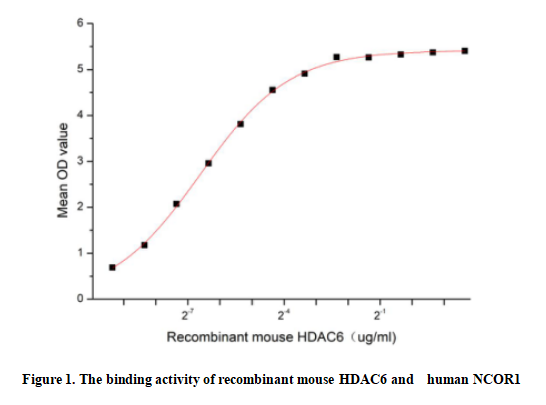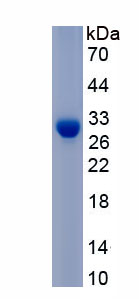Active Histone Deacetylase 6 (HDAC6) 

HD6; JM21
Overview
Properties
- Product No.APE906Mu01
- Organism SpeciesMus musculus (Mouse) Same name, Different species.
- ApplicationsCell culture; Activity Assays.
Research use only - DownloadInstruction Manual
- CategoryEnzyme & Kinase
- Buffer FormulationPBS, pH7.4, containing 0.01% SKL, 5% Trehalose.
- Traits Freeze-dried powder, Purity > 95%
- Isoelectric Point6.0
Sign into your account
Share a new citation as an author
Upload your experimental result
Review

Contact us
Please fill in the blank.
Activity test

Histone Deacetylase 6 (HDAC6) is an enzyme that belongs to the histone deacetylase family. It is responsible for removing acetyl groups from lysine residues in histone proteins, thereby playing a crucial role in regulating gene expression through chromatin remodeling. HDAC6 is unique among HDACs in that it is primarily localized in the cytoplasm and is involved in a variety of cellular processes, including protein degradation, cell motility, and autophagy.Besides,ANuclear Receptor Corepressor 1 (NCOR1) has been identified as an interactor of HDAC6, thus a functional binding ELISA assay was conducted to detect the interaction of recombinant mouse HDAC6 and recombinant human NCOR1. Briefly, HDAC6 was diluted serially in PBS with 0.01% BSA (pH 7.4). Duplicate samples of 100 μl were then transferred to NCOR1-coated microtiter wells and incubated for 1h at 37℃. Wells were washed with PBST and incubated for 1h with anti-HDAC6 pAb, then aspirated and washed 3 times. After incubation with HRP labelled secondary antibody for 1h at 37℃, wells were aspirated and washed 5 times. With the addition of substrate solution, wells were incubated 15-25 minutes at 37℃. Finally, add 50 µL stop solution to the wells and read at 450/630nm immediately. The binding activity of recombinant rat HDAC6 and recombinant human NCOR1 was shown in Figure 1, the EC50 for this effect is 0.01ug/mL.
Usage
Reconstitute in 10mM PBS (pH7.4) to a concentration of 0.1-1.0 mg/mL. Do not vortex.
Storage
Avoid repeated freeze/thaw cycles. Store at 2-8°C for one month. Aliquot and store at -80°C for 12 months.
Stability
The thermal stability is described by the loss rate. The loss rate was determined by accelerated thermal degradation test, that is, incubate the protein at 37°C for 48h, and no obvious degradation and precipitation were observed. The loss rate is less than 5% within the expiration date under appropriate storage condition.
Increment services
-
 BCA Protein Quantification Kit
BCA Protein Quantification Kit
-
 Molecular Mass Marker for Protein
Molecular Mass Marker for Protein
-
 Monoclonal Antibody Customized Service
Monoclonal Antibody Customized Service
-
 Polyclonal Antibody Customized Service
Polyclonal Antibody Customized Service
-
 Protein Activity Test Experiment Service
Protein Activity Test Experiment Service
-
 Electrophoretic Mobility Shift Assay (EMSA) Experiment Service
Electrophoretic Mobility Shift Assay (EMSA) Experiment Service
-
 Buffer
Buffer
-
 Lentivirus Packaging Experiment Service
Lentivirus Packaging Experiment Service
-
 Adenovirus Packaging Experiment Service
Adenovirus Packaging Experiment Service
-
 Real Time PCR Experimental Service
Real Time PCR Experimental Service
-
 Spike RBD Protein (S-RBD)
Spike RBD Protein (S-RBD)
-
 Protein G
Protein G
-
 Protein A
Protein A
Citations
- Dynein Function and Protein Clearance Changes in Tumor Cells Induced by a Kunitz-Type Molecule, Amblyomin-XPubmed:25479096
- Upregulated Expression of Intestinal Antimicrobial Peptide HD5 Associated with Renal Function in IgA NephropathyPubmed: 32089753
- HDAC6‐mediated α‐tubulin deacetylation suppresses autophagy and enhances motility of podocytes in diabetic nephropathyPubmed: 32885602







